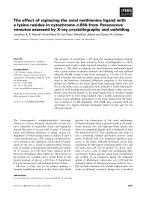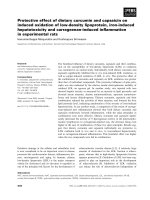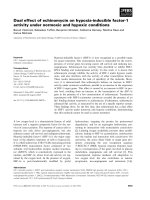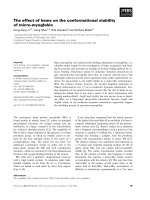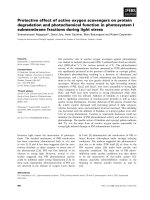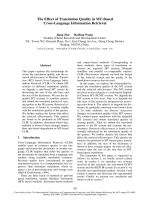Báo cáo khoa học: "nalgesic Effect of Meloxicam in Canine Acute Dermatitis – a Pilot Study" ppsx
Bạn đang xem bản rút gọn của tài liệu. Xem và tải ngay bản đầy đủ của tài liệu tại đây (67.78 KB, 6 trang )
Viking Höglund O. and Frendin J: Analgesic effect of meloxicam in canine acute
dermatitis – a pilot study. Acta vet. scand. 2002, 43, 247-252. – A double-blind trial
was performed on 12 client-owned dogs suffering from acute and painful dermatitis.
Clinically these cases represented pyotraumatic dermatitis and pyotraumatic folliculitis.
Six dogs were injected with meloxicam and 6 were given placebo. Signs of pain were
recorded on a visual analogue scale before administering the drug. This was repeated
over the following 2-3 days. All dogs were treated with cephalexin orally. Six dogs given
meloxicam and cephalexin showed an average decrease of pain on day 2 of 28.3%,
whereas the 6 dogs given placebo and cephalexin showed an average decrease of pain
on day 2 of 8.3%. When compared in the Wilcoxon two-sample test, using change in
percent and absolute change, the 2 groups yielded p = 0.026 and p = 0.064 respectively.
These findings indicate that meloxicam has an analgesic effect on acute dermatitis in
dogs.
dermatitis; meloxicam; NSAID; analgesic; canine; dogs; pain.
Acta vet. scand. 2002, 43, 247-252.
Acta vet. scand. vol. 43 no. 4, 2002
Analgesic Effect of Meloxicam in Canine Acute
Dermatitis – a Pilot Study
By O. Viking Höglund, and J. Frendin
Arninge Djurklinik, Täby, and Department of Large Animal Clinical Sciences, Faculty of Veterinary Medicine,
(Swedish University of Agricultural Sciences), Uppsala, Sweden.
Introduction
The effect of nonsteroidal anti-inflammatory
drugs (NSAID) on dermatitis is well known
from human trials and research using rats and
mice (Bayerl et al. 1998, Snyder 1975, Fleis-
cher 1999). To the best of our knowledge only
one study has been published showing whether
any of the modern NSAID impact the inflam-
matory process in acute dermatitis in the canine
species (Kimura & Doi 1998).
According to data sheets for medicines indi-
cated for usage in humans and animals, meloxi-
cam hinders the accumulation of leukocytes in
inflamed skin and other tissues (Medical Prod-
ucts Agency 2002). In addition, pruritus is a
known side effect of this agent in canines (Me-
dical Products Agency 2001) so meloxicam
does have some effect in the dermis of canines.
The aim of this study was to investigate the
analgesic effect of meloxicam on acute der-
matitis in the canine species. A second objec-
tive was to measure signs of central sensitisa-
tion, wind-up, after 3 weeks of treatment and to
investigate whether the healing process is im-
paired when canine dermatitis patients are
treated with meloxicam.
Materials and methods
Animals
Twelve client-owned dogs suffering from any
kind of moist, and when pinched, painful der-
matitis were included in this trial with their
owners' consent. Painful dermatitis was defined
as a VAS-value beyond 10 millimetres (se be-
low). The cases clinically represented pyotrau-
matic dermatitis (acute moist dermatitis) and
pyotraumatic folliculitis (local pyoderma).
Dogs showing no sign of pain when the affected
area was pinched, dogs on current NSAID med-
ication and dogs having suffered previous side
effects when treated with meloxicam were ex-
cluded from the study. One and the same person
made the inclusion and exclusion decisions and
conducted all examinations.
Treatment protocol
A randomised, controlled, double-blinded trial
was designed. Dogs were divided into 2 groups
of 6. Cases representing the 2 different diag-
noses were evenly distributed between the
2 groups. All dogs were given antibiotics
(cephalexin) at standard dosage. The average
dosages of cephalexin of group one (treated)
and 2 (control) were 18.8 mg/kg and 19.9
mg/kg respectively, twice daily. Dogs were
treated with antibiotics for 20 days. In addition,
group one was given meloxicam (Metacam,
5mg/ml, Boehringer Ingelheim Vetmedica
GmbH, Binger Straße 173, 55216 Ingelheim
am Rhein, Germany), subcutaneously, at stan-
dard dosage of 0.2mg/kg on day one, followed
by oral treatment (Metacam oral suspension
1.5mg/ml) at standard dosage of 0.1mg/kg for
the following one or 2 days, depending on re-
sponse to treatment.
The control dogs (group 2) were given an injec-
tion of saline. On day 2, these control dogs were
given oral treatment with ordinary sugar syrup
diluted with water. This placebo treatment con-
tinued for one or 2 days, depending on response
to treatment.
The examining veterinary surgeon and the own-
ers were blinded for treatment. In addition, the
results were assessed prior to decoding group
identity. The nurse who administered the initial
injection followed a randomised double-
blinded protocol.
A visual analogue scale (VAS) 0-100 mm was
used to record pain. At the first consultation on
day 1, the dogs were examined and the affected
area was pinched between the thumb and index
finger. Signs of pain were observed and scored
on the VAS. Painscore was judged by the inten-
sity of physical reactions, such as tail no longer
wagging, vocalising, head turning and signs of
aggression in response to the applied stress
(pinching).
The dogs were re-examined the following day.
An obvious change was defined as a minimum
decrease of painscore of 10 percent on the VAS.
If no obvious improvement was noted on re-ex-
amination, the owners were asked to return on
the third day.
Follow-up examination
Assessment of treatment was based on tele-
phone interviews and clinical examinations. All
owners were interviewed approximately 20
days after initiation of therapy. The procedure
for painscore was repeated in 4 of the dogs from
group one and 3 from group 2. The skin was in-
spected and tested for signs of wind-up, i.e. ob-
servations were made of the dogs' reactions to
248 O. Viking Höglund & J. Frendin
Acta vet. scand. vol. 43 no. 4, 2002
Table 1. Individual data derived from painscore on
VAS, day one and two.
Painscore Painscore Decrease of Decrease of
day 1 day 2 painscore painscore
(mm) (%)
Group 1
Case 1 53,5 42,5 11 20,5
Case 2 15 8,5 6,5 43,3
Case 3 11,5 8,5 3 26,1
Case 4 20 19 1 5
Case 5 30,5 19 11,5 37,7
Case 6 21,5 13,5 8 37,2
Group 2
Case 7 12,5 12,5 0 0
Case 8 22,5 22 0,5 2,3
Case 9 65 64,5 0,5 0,8
Case 10 15 14 1 6,7
Case 11 33 25 8 24,2
Case 12 25 21 4 16
Analgesic effect of meloxicam 249
Acta vet. scand. vol. 43 no. 4, 2002
Painscore (VAS 0-100)
100
90
80
70
60
50
40
30
20
10
0
Case
1
Case
2
Case
3
Case
4
Case
5
Case
6
Day 1
Day 2
100
90
80
70
60
50
40
30
20
10
0
Painscore (VAS 0-100)
Case
7
Case
8
Case
9
Case
10
Case
11
Case
12
Day 1
Day 2
Figure 1. Group 1 (treated). Pain scored on a visual
analogue scale (VAS) in 6 dogs with acute dermatitis
on day one (blue columns), and day 2 (red columns),
approximately 24 h after initiating therapy with
meloxicam and cephalexin.
Figure 2. Group 2 (control). Pain scored on a visual
analogue scale (VAS) in 6 control dogs with acute
dermatitis on day one (blue columns), and day 2 (red
columns), approximately 24 h after initiating therapy
with saline and cephalexin.
Group one
n=6
Group two
n=6
Average decrease
day 1-2
% (0-100)
100
90
80
70
60
50
40
30
20
10
0
Meloxicam
Placebo
Decrease of painscore, mm
50
40
30
20
10
0
Meloxicam
Placebo
100
80
60
40
20
0
Decrease of painscore,
percent
0 20 40 60 80 100
100
80
60
40
20
0
Painscore day 1
Painscore day 2
Meloxicam
Placebo
Figure 3. Average decrease in signs of pain scored
on VAS from day one to day 2. Change expressed as
a percentage. Group 1 was given meloxicam and
cephalexin, group 2 was given placebo and
cephalexin. Groups compared in Wilcoxon two-sam-
ple test p = 0.026.
Figure 4. Groups 1 and 2. Decrease of painscore on
VAS from day one to day 2. Absolute decreases
shown in millimetres. Each individual's change is
displayed. Groups compared in Wilcoxon two-sam-
ple test p = 0.064.
Figure 5. Groups 1 and 2. Decrease of painscore on
VAS from day one to day 2. Relative decreases shown
in percent. Each individual's change is displayed.
Groups compared in Wilcoxon two-sample test p =
0.026.
Figure 6. Painscore on VAS for all individuals,
both groups. Day one is shown on x-axis and day 2 is
shown on y-axis.
soft stimuli (using a cotton bud) and tempera-
ture change (using a spoon kept in a standard
household freezer) of the previously infected
and inflamed area.
Statistics
The change of painscore on the VAS from day
one to day 2 equals the analgesic effect. Groups
were compared using the Wilcoxon two-sample
test using change in percent and absolute
change.
Results
The results of pain assessments are shown in
Figs. 1-6 and Table 1.
The painscores on VAS for all dogs ranged be-
tween 11.5 and 65 on day one before initiating
treatment. On day 2 the scores had decreased by
an average of 28.3 percent for group one and
8.3 percent for group 2 (Figs. 1-3).
Groups compared using the Wilcoxon two-
sample test yielded p = 0.064 when comparing
decrease of painscores on VAS in millimetres
(Fig. 4).
When the groups' decrease of painscore on
VAS was compared as a percentage, the
Wilcoxon two-sample test yielded p = 0026
(Fig. 5).
The 5 dogs (cases 4, 7, 8, 9, 10) that clearly had
not improved on day 2 were examined again on
day 3. Four of these 5 dogs (cases 7, 8, 9, 10)
were treated with antibiotics and placebo, be-
longing to group 2.
When the dog owners were interviewed after 3
weeks, all reported a complete recovery with-
out relapses. The dermis of the 7 dogs accessi-
ble for re-examination after 3 weeks was diag-
nosed as having gone through a normal healing
process. There was no abnormal reaction to soft
touch, pinch or cold stimuli.
Discussion
Pain relief is an important aspect of treatment
during inflammatory processes and for the
well-being of the animal. The analgesic effect,
according to the differences in scores on the
VAS after only one day of treatment with
meloxicam in the present study, indicates that
meloxicam has an analgesic effect in the dermis
of the canine species. After 3 weeks of treat-
ment with antibiotics all dogs were fully recov-
ered. Follow-up examinations and interviews
revealed no signs of wind-up and there were no
differences in healing between the 2 groups af-
ter termination of therapy.
An infection in the skin is sometimes a painful
process due to the inflammatory processes ini-
tiated. The microorganisms will be reduced in
numbers by the administration of antibiotics.
This should eventually reduce the inflammatory
process on the affected area. Therefore, a re-
duction of pain will be seen when the infection
is treated with antibiotics.
NSAID inhibit cyclo-oxygenase 1 (COX-1)
and 2 (COX-2). COX-1 inhibits platelet func-
tion via blockade of thromboxane A2 (TxA2)
formation and COX-2 mediates inflammatory
responses. Meloxicam has analgesic, anti-in-
flammatory, antipyretic and anti-exudative ef-
fects. After subcutaneous administration a
maximum plasma concentration is reached af-
ter 2
1
⁄2 h. The half-life of meloxicam is 24 h. The
main cause of meloxicam's effects is thought to
be the inhibition of COX-2. Meloxicam also
shows significant TxA2 inhibition, although
less than traditional NSAID. The result is re-
duced synthesis of inflammatory mediators,
prostaglandins, which play an important role in
stimulating pain receptors (Medical Products
Agency 2002, Rinder et al. 2002).
Pyotraumatic dermatitis is described as a super-
ficial inflammatory process of undetermined
cause and pathogenesis. Bacteria colonise the
surface of the lesion but this is not a true skin
infection. Preferred treatment is a corticos-
teroid, topical or oral. In addition, the area is
250 O. Viking Höglund & J. Frendin
Acta vet. scand. vol. 43 no. 4, 2002
clipped, cleaned and treated with a drying solu-
tion and possibly antibiotic cream or ointment
(Scott et al. 2000, Reinke et al. 1987, Harvey,
McKeever 2000).
Pyotraumatic folliculitis is a superficial ulcera-
tion in the dermis, which also includes a deep
suppurative and necrotizing folliculitis and oc-
casional furunculosis. These types of lesions,
true local pyodermas, have been described as
thickened with surrounding papules and pus-
tules. Treatment includes systemic antibiotics.
The use of glucocorticoids is contraindicated
due to possible immunosuppressive effect
(Scott et al. 2000).
What appears to be a superficial process (i.e.
pyotraumatic dermatitis, acute moist dermati-
tis) in clinical terms, could actually be a deep
process (i.e. pyotraumatic folliculitis). Al-
though the area is clipped and palpated, the 2
types are sometimes confused. In this study, the
respective diagnoses for pyotraumatic dermati-
tis and pyotraumatic folliculitis were based on
the clinical appearance of the skin lesions, and
the 2 diagnoses were evenly distributed be-
tween the 2 groups. The diagnosis was not con-
firmed histologically as histological confirma-
tion of the diagnosis was considered less
important in these cases. The primary task was
to assess the analgesic effect.
Regardless of whether a dermatitis is superfi-
cial or deep, the process can cause considerable
pain and discomfort. In the present study, the
dogs' reactions to palpation of the inflamed area
were used to score pain. A study assessing post-
operative pain in dogs showed that behavioural
response (response to palpation, activity, men-
tal status, posture and vocalisation) and physio-
logical measurements can be used reliably to
assess degree of pain and response to anal-
gesics (Firth & Haldane 1999).
If meloxicam could be used as a complement to
antibiotics in the treatment of pyotraumatic fol-
liculitis, relief might be achieved in a shorter
time compared to the use of antibiotics alone.
No signs of impaired healing were seen in this
study. Reports have been published on the sub-
ject of NSAID and impaired healing of bone
tissue in rats, humans and horses (Bo et al.
1976, Giannoudis et al. 2000, Rohde et al.
2000). The question of whether NSAID impair
wound healing in skin is controversial and re-
ports contradict each other. NSAID topically
applied on dermal and epidermal wounds in
pigs markedly reduced inflammation but did
not influence the healing process (Alvarez et al.
1984). On the other hand, diclofenac and in-
domethacin have been shown to influence the
healing of normal and ischaemic incisional
wounds in rat skin. However, in certain doses
the drugs improved the healing of normal
wounds. The healing of ischaemic wounds, us-
ing a flap model, was unaffected after 10 days
but decreased after 20 days (Quirinia & Viidik
1997).
Other studies considered the effects of meloxi-
cam, previously named miloxicam, on cuta-
neous tissue in other species. The effects of
meloxicam on acute inflammation in 6 ponies
were assessed. Exudate leukocyte numbers
were significantly reduced in drug-treated
ponies, as were exudate concentrations of
prostaglandin E and F (Lees et al. 1991).
The anti-exudative effect of meloxicam on sub-
plantar induced oedema exceeded that of pirox-
icam, diclofenac, indomethacin and naproxen
in a comparative study (Engelhardt et al. 1995).
In addition, meloxicam showed greatest po-
tency when comparing inhibition of granuloma
formation induced by cotton pellets implanted
into the subcutaneous space in rats.
This study shows that meloxicam seems to of-
fer an analgesic effect during the processes in-
volved in acute dermatitis in dogs. Further stud-
ies are needed on the use of meloxicam, as well
as other NSAID, in treating dermatitis in the ca-
nine dermis.
Analgesic effect of meloxicam 251
Acta vet. scand. vol. 43 no. 4, 2002
Acknowledgements
The authors would like to thank Boehringer Ingel-
heim for support with medical products and Dr G.
Nyman, Assistant Professor at the Department of
Large Animal Clinical Sciences, Swedish University
of Agricultural Sciences, for her scientific advice.
There was no financial support involved.
References
Alvarez OM, Levendorf KD, Smerbeck RV, et al: Ef-
fect of topically applied steroidal and nonste-
roidal anti-inflammatory agents on skin repair
and regeneration. Fed Proceedings 1984, 43,
2793-2798.
Bayerl C, Pagung R, Jung EG: Meloxicam in acute
UV dermatitis – a pilot study. Photodermatol
Photoimmunol Photomed. 1998, 14, 167-169.
Bo J, Sudmann E, Marton PF: Effect of in-
domethacin on fracture healing in rats. Acta Or-
thop. Scand. 1976, 47, 588-599.
Engelhardt, G, Homma D, Schlegel K, et al: Anti-in-
flammatory, analgesic, antipyretic and related
properties of meloxicam, a new non-steroidal
anti-inflammatory agent with favourable gas-
trointestinal tolerance. Inflamm Res 1995, 44,
423-433.
Firth A. M, Haldane S. L: Development of a scale to
evaluate postoperative pain in dogs. J. Am. Vet.
Med. Assoc. 1999, 214, 651-659.
Fleischer AB Jr: Treatment of atopic dermatitis: Role
of tacrolimus ointment as a topical noncorticos-
teroidal therapy. J. Allergy Clin. Immunol. 1999,
104, 126-130.
Giannoudis PV, MacDonald DA, Matthews SJ et al:
Nonunion of the femoral diaphysis. The influence
of reaming and non-steroidal anti-inflammatory
drugs. J. Bone Joint Surg. Br. 2000, 82, 655-658.
Harvey RG, McKeever PJ: A colour handbook of
skin diseases of the dog and cat (2nd impression).
Iowa State University Press, 2000, p 32.
Kimura T, Doi K: Effects of indomethacin on sun-
burn and suntan reactions in hairless descendants
of Mexican hairless dogs. Histol. Histopathol.
1998, 13, 29-36.
Lees P, Sedgwick AD, Higgins AJ, et al: Pharmaco-
dynamics and pharmacokinetics of miloxicam in
the horse, Br. Vet. J.,1991, 147, 97-108.
Medical Products Agency, Box 26, S-751 03 Upp-
sala, Sweden.
Quirinia A, Viidik A: Diclofenac and indomethacin
influence the healing of normal and ischaemic in-
cisional wounds in skin. Scand. J. Plast. Reconstr.
Surg. Hand. Surg. 1997, 31, 213-219.
Reinke SI, Stannard AA, Ihrke PJ, et al: Histopatho-
logic features of pyotraumatic dermatitis. J. Am.
Vet. Med. Assoc. 1987, 190, 57-60.
Rinder HM, Tracey JB, Souhrada M, et al: Effects of
meloxicam on platelet function in healthy adults:
a randomized, double-blind, placebo-controlled
trial. J. Clin. Pharmacol. 2002, 42, 881-886.
Rohde C, Anderson DE, Bertone AL, et al: Effects of
phenylbutazone on bone activity and formation
in horses Am J. Vet. Res. 2000, 61, 537-543.
Scott, Miller, Griffin: Muller and Kirk's Small Ani-
mal Dermatology. (6
th
edn), W B Saunders Co,
2000, pp 238-239, 300-303, 1104.
Snyder DS: Cutaneous effects of topical in-
domethacin, an inhibitor of prostaglandin synthe-
sis, on UV-damaged skin. J. Invest. Dermatol.
1975, 64, 322-325.
Sammendrag
Smärtstillande effekt av meloxicam vid akut dermatit,
en pilotstudie.
En dubbelblindad studie genomfördes på 12 hundar
med akut och smärtsam dermatit. Kliniskt represen-
terades dessa av pyotraumatisk dermatit (hotspot)
och pyotraumatisk follikulit (pyodermi). Sex hundar
injicerades med meloxicam och sex gavs placebo.
Grad av smärta registrerades på en visuell analog
skala (VAS) innan administrering av substans. Detta
upprepades under de följande 2-3 dagarna. Alla hun-
dar gavs cefalexin oralt. De 6 hundar som gavs
meloxicam och cefalexin hade en smärtlindring med
ett medelvärde av 28,3% efter ett dygn. De hundar
som gavs placebo och cefalexin hade en smärtlin-
dring med ett medelvärde av 8,3%. Jämförelse av
grupperna i Wilcoxon tvåprovtest (rangsummatest)
av procenduell och absolut förändring gav p = 0,026
respektive p = 0,064. Resultaten tyder på att meloxi-
cam har smärtstillande effekt vid akut dermatit hos
hundar.
252 O. Viking Höglund & J. Frendin
Acta vet. scand. vol. 43 no. 4, 2002
(Received May 23, 2002; accepted August 20, 2002).
Reprints may be obtained from: O. Viking Höglund, Arninge Djurklinik, Ritarslingan 18, S-187 66 Täby, Swe-
den. E-mail: , tel: +46-8-6300290, fax: +46-8-6300917.



